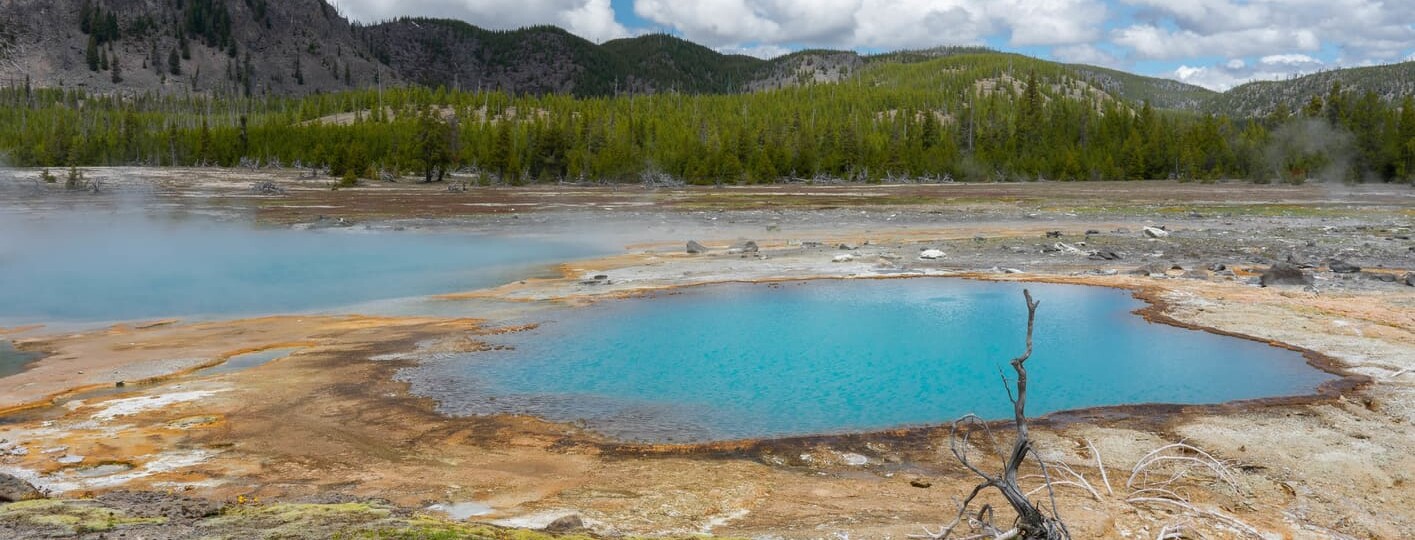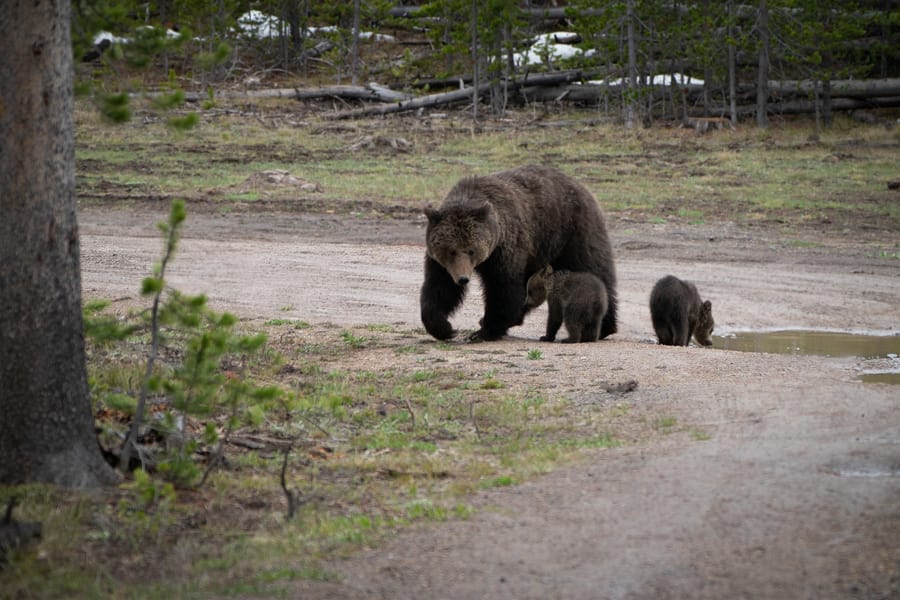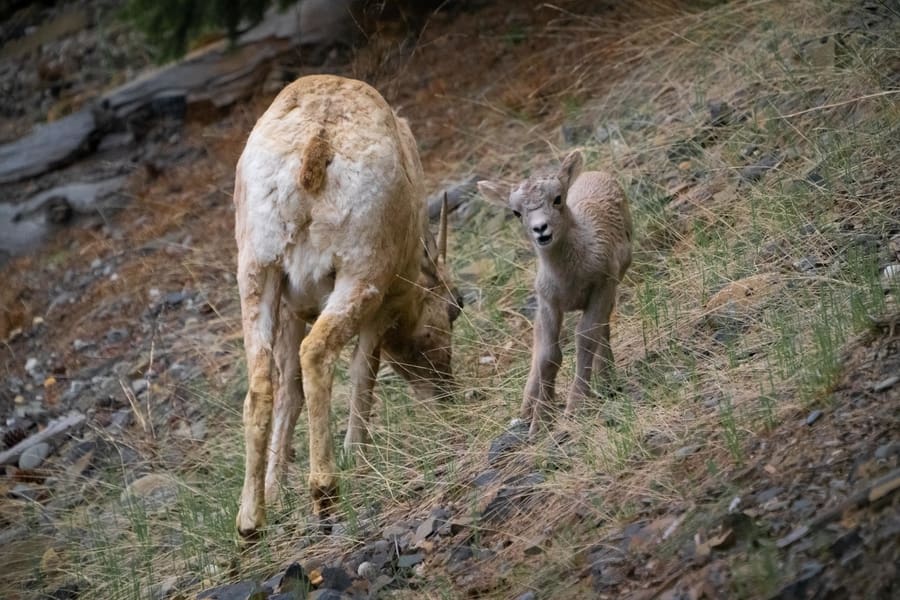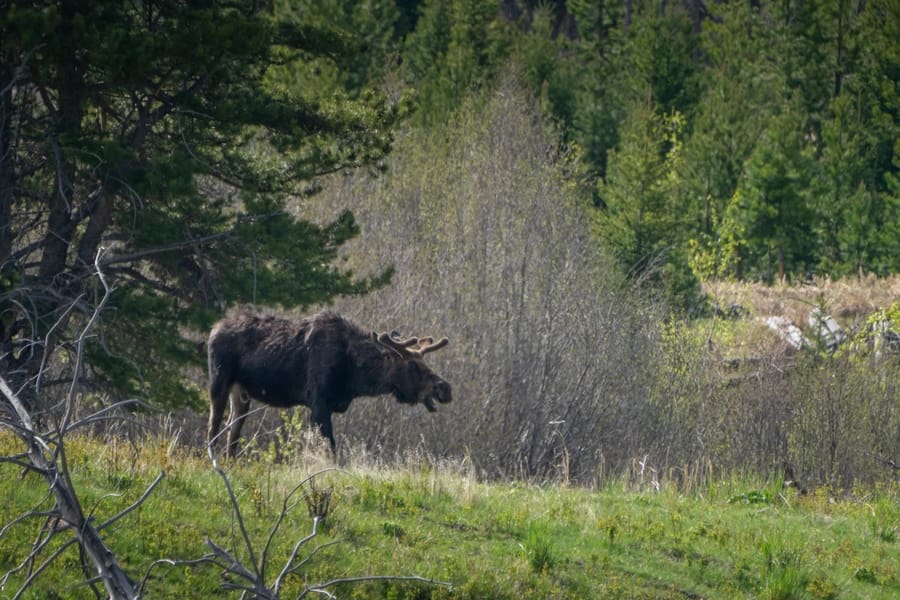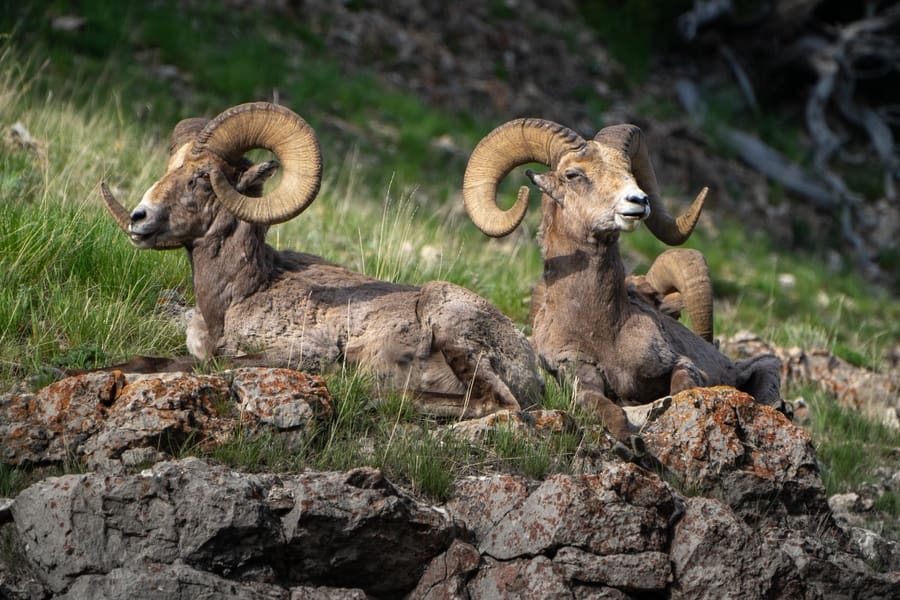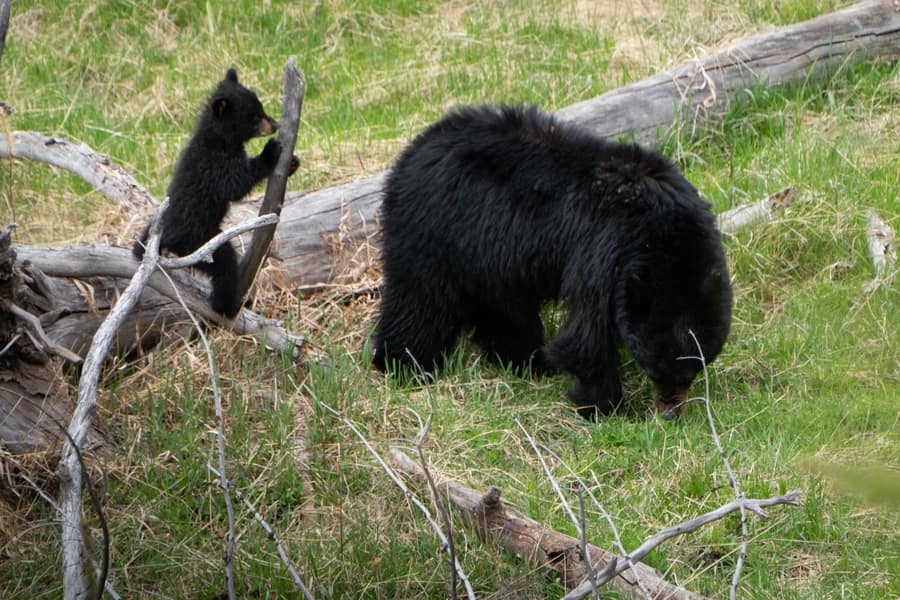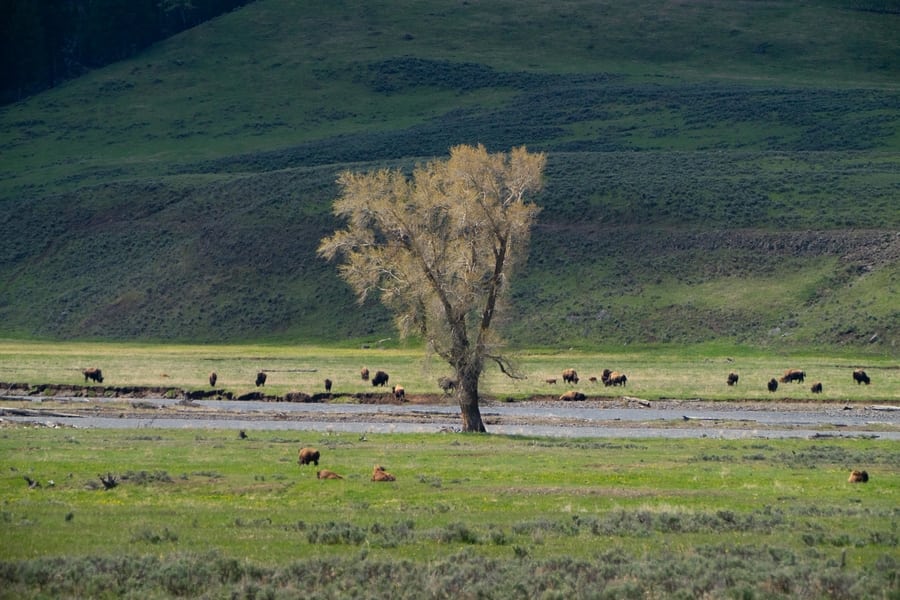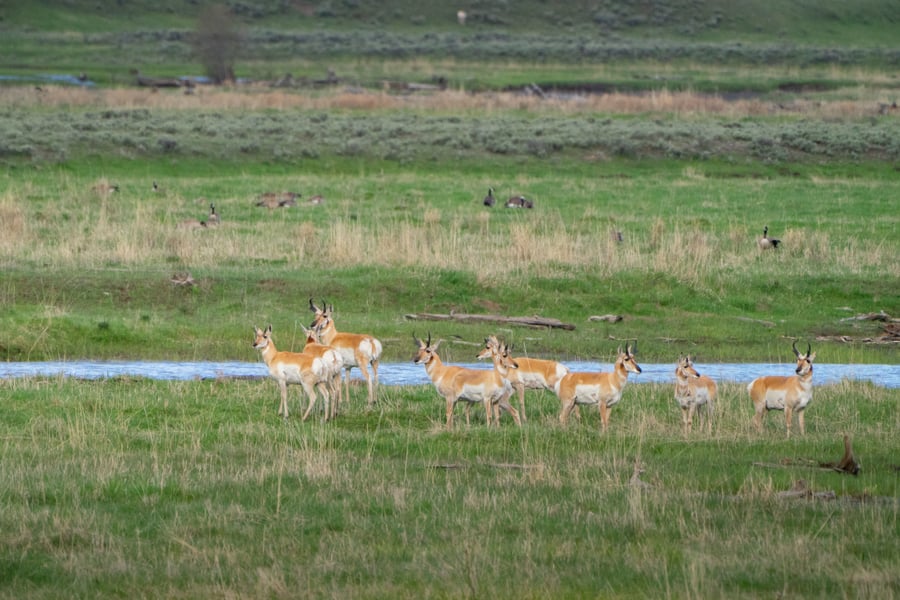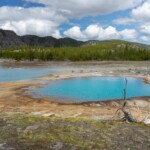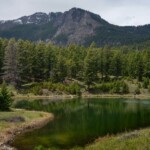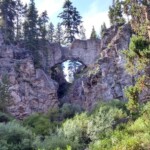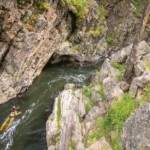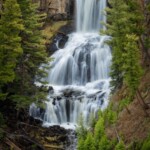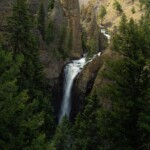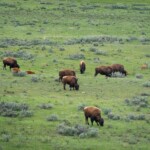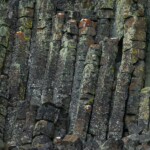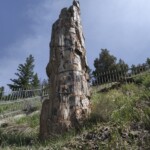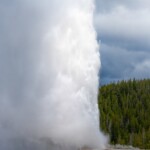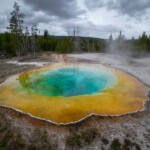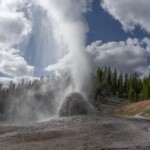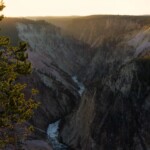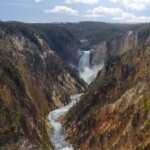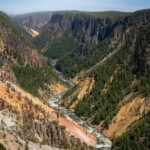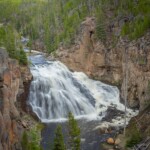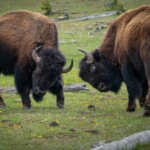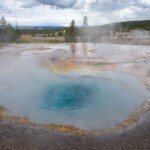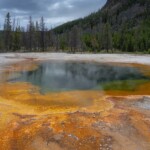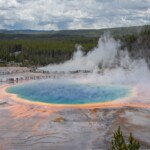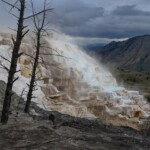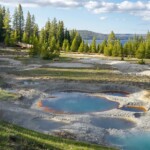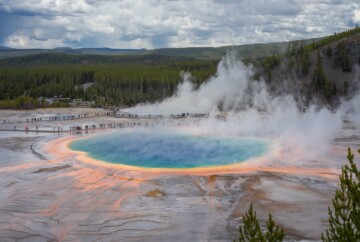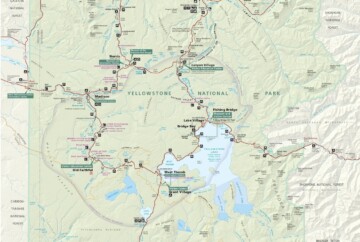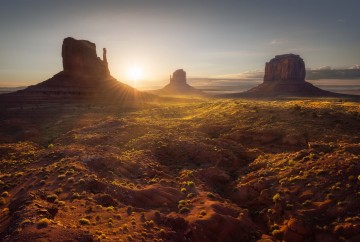Are you wondering what the best things to do in Yellowstone are? The oldest national park in the United States stands out for its incredible geothermal activity and its extensive meadows full of fauna. Although I have visited many US National Parks, there are none as interesting as Yellowstone.
We couldn’t visit Yellowstone, Wyoming, during our first 10-day West Coast USA road trip, as this park requires more time than we had. However, on our second trip to the American West, we spent 10 days in Yellowstone and Grand Teton National Park (only 1.5 days in GT), and it was great. If you have even more time, don’t hesitate to spend even 2 weeks there, since there are plenty of amazing places to visit in Yellowstone.
The best way to explore this old volcano is to rent a car. This is also the best way to spot wildlife in the park, since, at any time, a buffalo, bear, or wolf could cross the road.
I am sure that this national park will surprise you even more than you imagine, but to get an idea, here are the best things to do in Yellowstone.
1. Grand Prismatic Spring, a must-see at Yellowstone
Grand Prismatic Spring is the most popular image taken of Yellowstone National Park and the largest hot spring in the United States (and the third-largest in the world). With an area of 90 by 80 and a depth of 164 feet, what make this hot spring unique are its bright colors, ranging from red to blue to oranges, yellows, and greens. An authentic work of art created by Mother Nature.
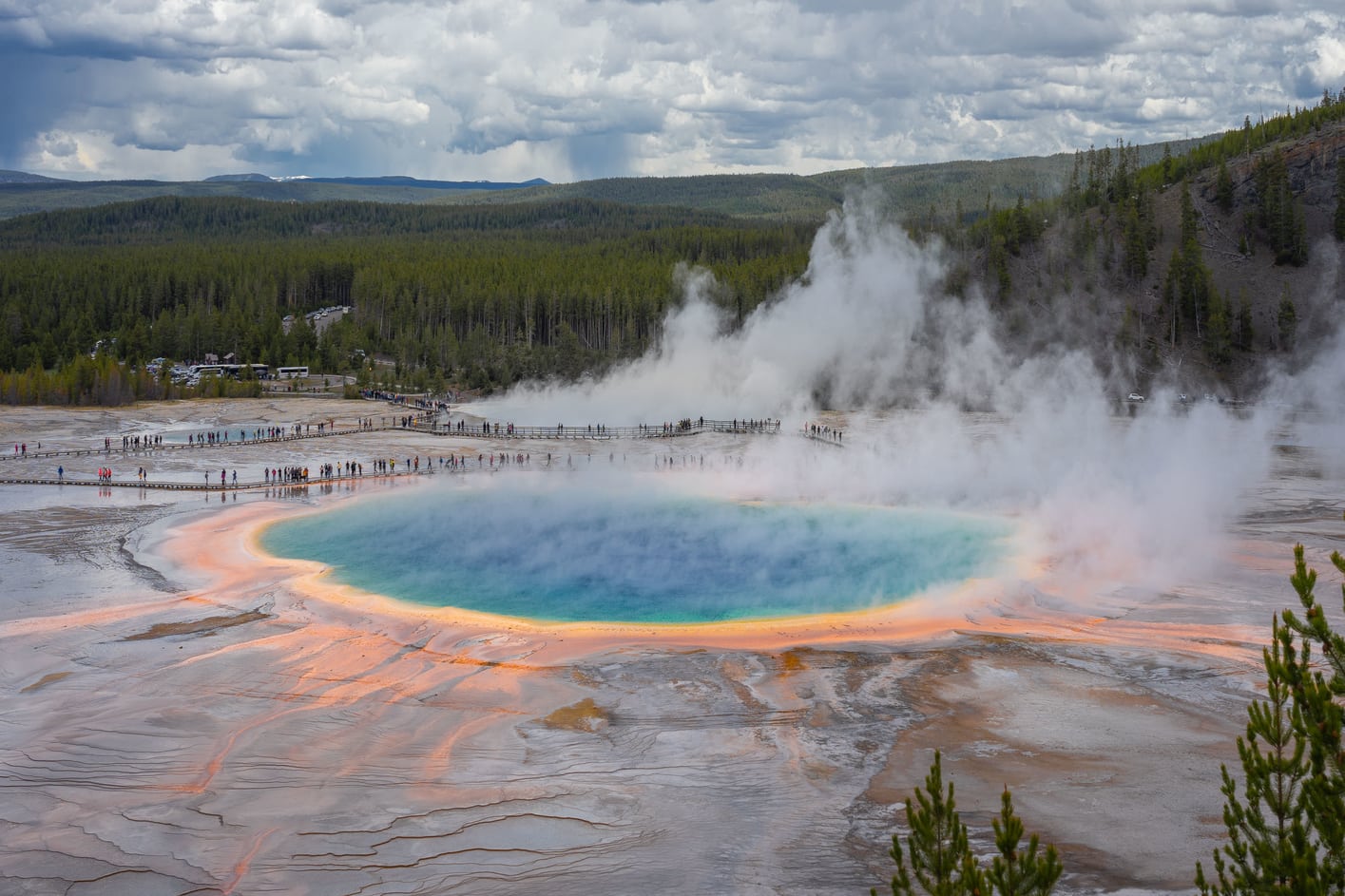
1. Grand Prismatic Spring, a must-see at Yellowstone
This geothermal spring is not isolated; it’s in the center of the Midway Geyser Basin, along with other thermal pools such as the Turquoise Pool, the Opal Pool, and the crater of the Excelsior geyser, which is currently inactive.
To enjoy the vivid colors of the Grand Prismatic Spring, I recommend timing your visit with a sunny day. The best way to appreciate the great beauty of this geothermal feature is to hike the first section of the trail that leads to the Fairy Falls, where you’ll get amazing panoramic views.
The Fairy Falls trail loop takes 5 hours, but you can visit the outlook with views of the Midway Geyser Basin in just one hour.
2. Old Faithful, the world-famous Yellowstone geyser
Old Faithful is probably best known for being one of the most predictable geysers out there. Hence its name, Old Faithful. It throws water into the air at a height of between 180 and 246 feet approximately every 90 minutes.
Unlike other geysers I’ve seen before, this geyser maintains its eruption for more than 5 minutes, making it one of the main attractions of Yellowstone National Park.
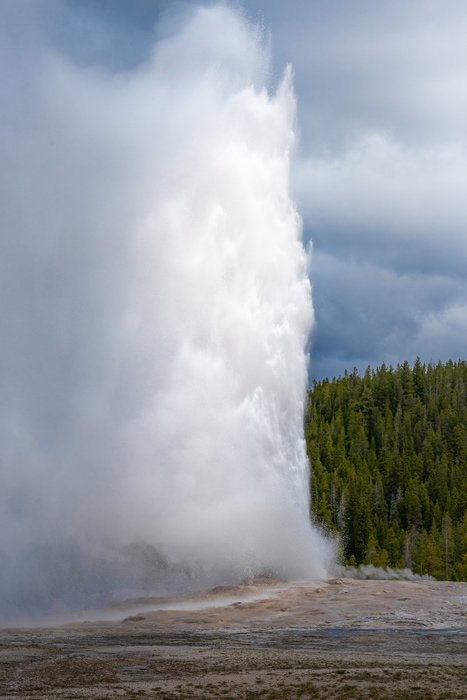
2. Old Faithful, the world-famous Yellowstone geyser
It is also accessible to everyone, making it a good place to visit in Yellowstone with kids. In the visitor center next to the geyser, there is a counter that tells you when the next eruption will occur.
In addition to seeing it from the ground, if you want to experience this geyser’s eruption from above, I recommend walking the path that ascends to the observation point. To get there, you can also hike the loop trail that passes through Solitary Geyser, a very quiet area that we loved. Although the trail is 3 miles, with an elevation gain of 164 feet, it is well worth it.
Old Faithful is in the Upper Geyser Basin, where you can find many other geothermal features, such as hot springs and other geysers that I will talk about below.
3. Morning Glory Pool and the hot spring trail to do in Yellowstone
Old Faithful is undoubtedly the main attraction of the Upper Geyser Basin, but it is not the only geyser in the basin. To see other geothermal wonders in the area, I recommend taking the trail that borders Old Faithful to cross Geyser Hill and following the Firehole River north towards Morning Glory Pool.
Along the way, you will find hundreds of pools of boiling water, geysers, and brightly colored hot springs. The essential stops on this route are Castle Geyser, which is shaped like a castle and erupts every 10-12 hours; Grand Geyser, which is the highest predictable geyser in the world, is 197 feet high, and erupts every 7-15 hours; Riverside Geyser, a geyser right on the bank of the Firehole River; and Morning Glory Pool, the most beautiful hot spring in Yellowstone for me.
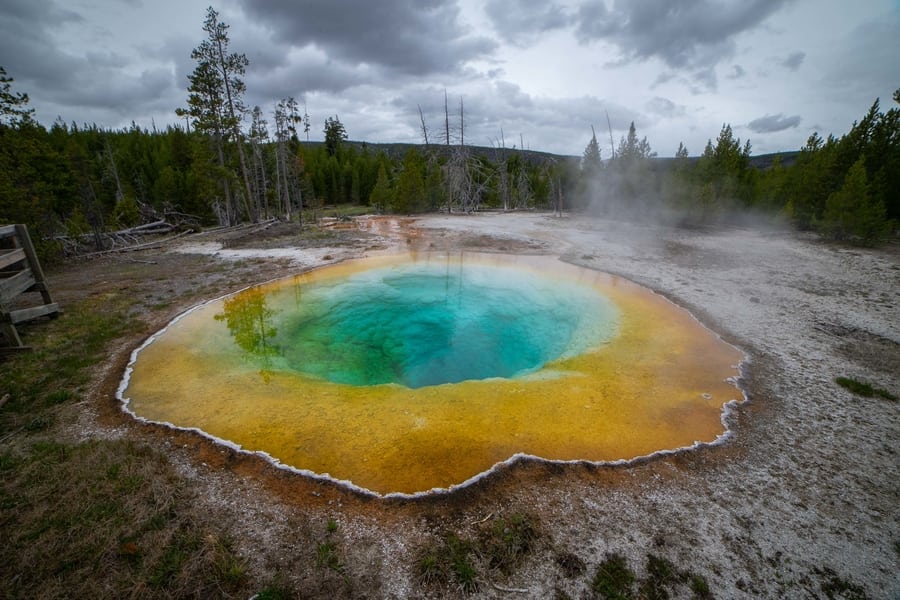
3. Morning Glory Pool and the hot spring trail to do in Yellowstone
The trail to Morning Glory is 1.7 miles, which you could cover in half an hour one way if it weren’t for the number of incredible places where you will want to stop to take photos. Reserve at least an hour and a half for going and coming back. The path to Morning Glory Pool is paved, and there is even an alternate wheelchair accessible path (although this path only passes by some of the major geysers).
After Morning Glory Pool, the path continues to Biscuit Basin, but it is no longer paved, and the hot springs are dispersed for another 0.6 miles on what is known as Artemisa Trail. I will talk about Biscuit Basin and the trails you can hike around there later in this article.
4. Mammoth Hot Springs, one of the main tourist attractions in Yellowstone
If Mammoth Hot Springs stands out for something, it’s for its incredible travertine terraces. These geothermal formations occur when thermal water rises through limestone, dragging calcium carbonate particles with it. Upon reaching the surface, carbon dioxide is released, and calcium carbonate is deposited, forming what is known as travertine, the white limestone that forms this type of terrace.

4. Mammoth Hot Springs, one of the main tourist attractions in Yellowstone
The peculiarity of these formations is that they usually harbor thermophiles, delicate organisms that only live in environments with high temperatures. These bacteria populations give the terraces of Mammoth Hot Springs their striking color. Minerva Terrace and Canary Spring stand out as two particular places to visit.
In addition to visiting these two terraces on foot, enjoy the otherworldly landscapes in what is known as the Lower Terrace by driving the one – way Upper Terrace Loop Drive, where you can access other travertine terraces. Visiting the terraces is definitely one of the best things to do in Yellowstone.
5. Spotting animals in Lamar Valley, the best activity in Yellowstone
Yellowstone receives two types of visitors: volcano enthusiasts and wildlife lovers. If you are one of the latter, I assure you that you will want to spend hours traveling the road that crosses the Lamar Valley.
Wolves, grizzly bears, black bears, coyotes, elk, bison, badgers, otters, and foxes are just a few of the inhabitants of this amazing place. The best times to visit the Lamar Valley in Yellowstone are at sunrise and sunset. These times of day are when the animals are most active and it’s easiest to spot them.
If you want to increase your chances of spotting any of these animals in the wild, I recommend following the “spotters”, people who are equipped with binoculars and telescopes and spend a good number of hours searching for animals. I assure you, there is nothing more fun to do in Yellowstone.
If you are a photographer, keep in mind that you will need a good telephoto lens to take photographs in this valley, since the animals are usually far off, in the mountains. In my case, I had a 100-400 mm lens plus a 1.4X teleconverter that I rented (here I tell you where to rent camera gear), and it was too short to photograph in Lamar Valley. For Lamar Valley, I recommend a 600mm plus 1.4X or even 2X teleconverter. However, 100-400mm is enough to photograph wildlife elsewhere in Yellowstone.
6. Grand Canyon of the Yellowstone and Yellowstone Falls (Wyoming)
The Grand Canyon of the Yellowstone is one of the must-see places in this national park. For me, it is the most impressive canyon I have ever visited, even considering the Grand Canyon of the Colorado River.
Its soft rhyolite hills lit in the dim light of dawn and its two imposing waterfalls form one of the best landscapes in Yellowstone.
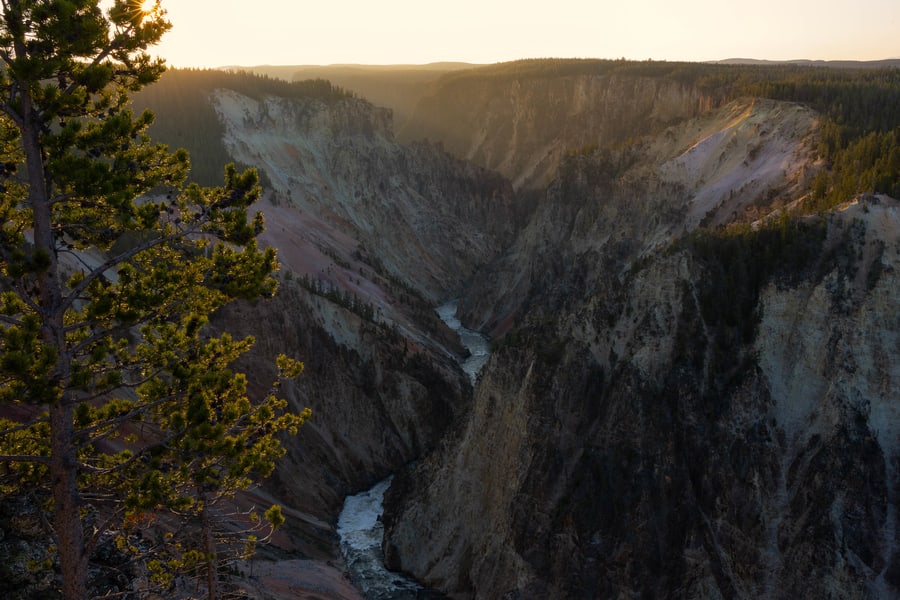
6. Grand Canyon of the Yellowstone and Yellowstone Falls (Wyoming)
Shades of green, ocher, and yellow tell you the story of this canyon; it formed thousands of years ago but has not stopped changing due to the water, wind, and geothermal activity in the area.
This canyon has a length of 20 miles and a depth of more than 984 feet. The Yellowstone River runs through it, and there, if you look closely, you can see that the canyon is still alive. Small fumaroles are born from the depths of the canyon.
You can visit both sides of this natural wonder, and the view will change dramatically from the north rim to the south rim.
North Rim of the Grand Canyon of the Yellowstone
There are many awesome outlooks on the one-way North Rim Drive. The first is Brink of Lower Falls, where, after descending on the trail, you will have fantastic views of the Upper and Lower Yellowstone River Falls.
Then, you will pass Lookout Point, from which you can also access the Red Rock Point, both with views of the Lower Falls.

North Rim of the Grand Canyon of the Yellowstone
Continue to Grand View, where the views of the canyon are breathtaking. And finally, visit Inspiration Point, which is my favorite viewpoint on the North Rim. Reaching this point was difficult, since the road was cut, but we decided to go on foot, which was totally worth it.
One of the best things to do in Yellowstone is to look for the pinnacles on the north rim of the Grand Canyon, where ospreys nest from May to September. We spotted two nests.
South Rim of the Grand Canyon of the Yellowstone
To visit the south rim of the Grand Canyon of the Yellowstone, take the South Rim Drive from the main road.
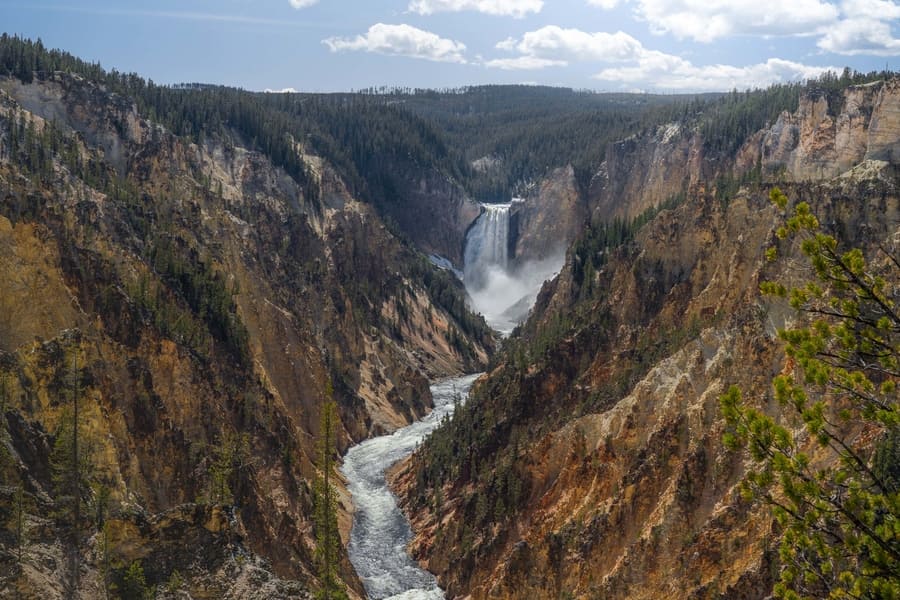
South Rim of the Grand Canyon of the Yellowstone
On this rim, you can visit the Upper Falls Viewpoint, where you can get a closer look at this waterfall and start Uncle Tom’s Trail, which descends to the base of the Lower Fall, where you can cool off with the mist. When we went, Uncle Tom’s Trail was closed for maintenance, but it’s one of the most popular hiking trails in Yellowstone. Of course, keep in mind that you must descend and then ascend 328 metal steps, which is not suitable for people with vertigo.
In addition to this route, on the south rim, you will find what, for me, is the most picturesque viewpoint in the entire Grand Canyon, Artist Point, which has an impressive frontal view of the Lower Falls. The trail to Ribbon Lake, which begins along the canyon, also starts there. We did the first section, and the views from there were magnificent.
7. Norris Geyser Basin, one of the best things to do in Yellowstone
Norris Geyser Basin is one of the geothermal basins you have to visit in Yellowstone. It is perhaps the hottest, most acidic, and most volatile of the park’s basins. It changes completely from one year to the next: new geysers appear, others become inactive, some springs change color or begin to spit mud… In short, a land of change marked by the instability of the terrain.
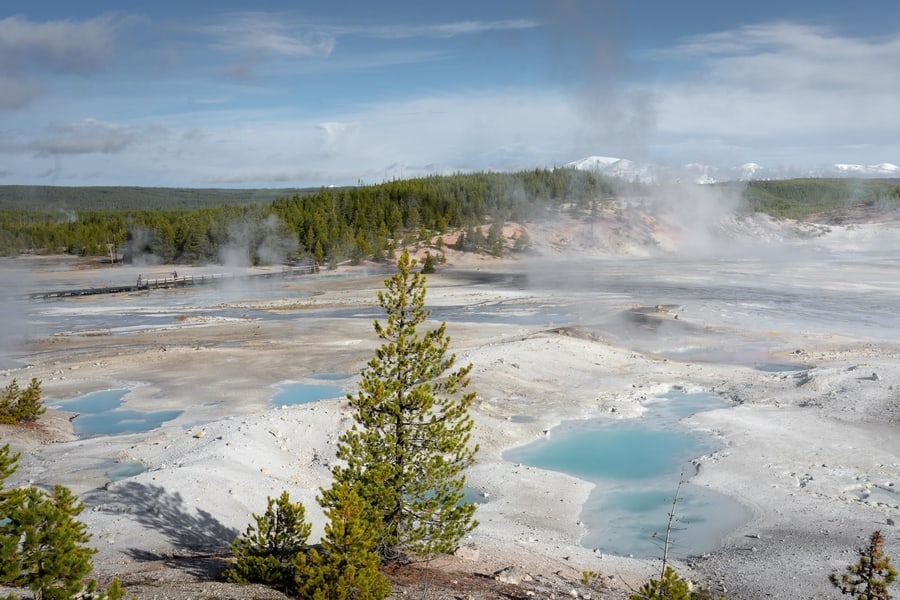
7. Norris Geyser Basin, one of the best things to do in Yellowstone
Within Norris Basin, there are two main areas: Porcelain Basin, which you can visit via a short route where you will enjoy the celestial and porcelain colors of the ground, and Back Basin, which goes through more remote paths full of hot springs, mud pools, and spectacular geysers.
Steamboat Geyser is the most popular, as it’s the highest active geyser in the world and a must-see in Yellowstone. This geyser shoots water up to 298 feet high, but unfortunately, it is quite unpredictable. It erupts in periods ranging from 3 days to 50 years, so seeing it is a matter of luck. Of course, as it’s so high and makes so much noise, if you are in the park and it erupts, you’ll probably see its column of steam and water from a distance.
8. Artists Paintpots, the most colorful place to visit in Yellowstone
Artists Paintpots looks like an oil painter’s palette, laden with ocher, green, and red colors, and is undoubtedly one of the tourist spots in Yellowstone that looks like it’s from another planet. It is located south of Norris Geyser Basin and stands out for its bubbling clay pots.
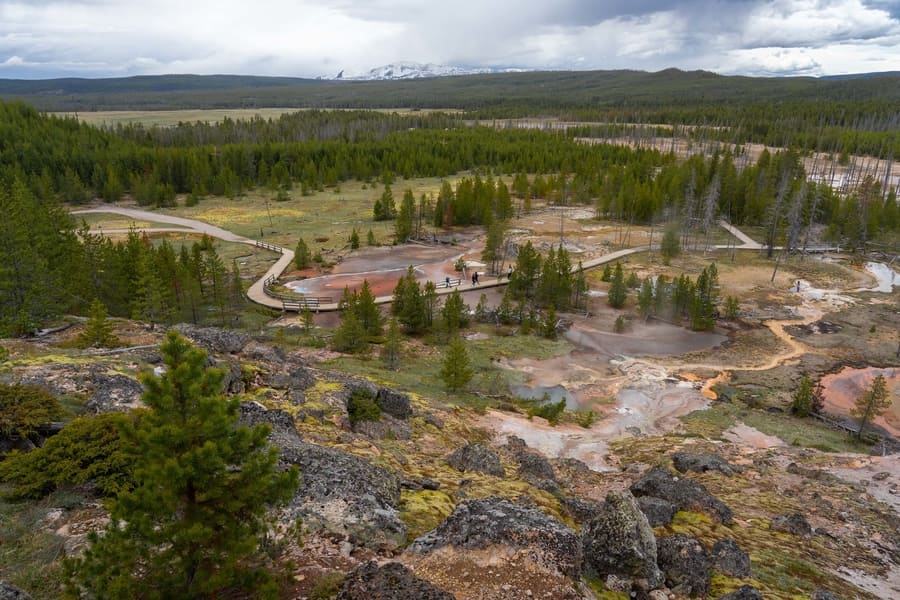
8. Artists Paintpots, the most colorful place to visit in Yellowstone
To get there, you must go into the forest for about five minutes before reaching the main, bubbling groundwater. The route is a quite short loop, and it reaches a higher elevation in the central section, where you can get the best views of the Artists Paintpots, one of the main attractions of Yellowstone.
9. Biscuit Basin, pure geothermal activity in Yellowstone
I’ve already mentioned Biscuit Basin, a basin full of geothermal features located in the Upper Geyser Basin above Old Faithful and connected to this famous Yellowstone geyser by the Artemisia trail. If, like us, you only walk to the Morning Glory Pool from Old Faithful, then you can drive to Biscuit Basin to discover the last section of the trail, where you will see, in addition to the inactive Artemisia Geyser, the beautiful Mirror Pool.
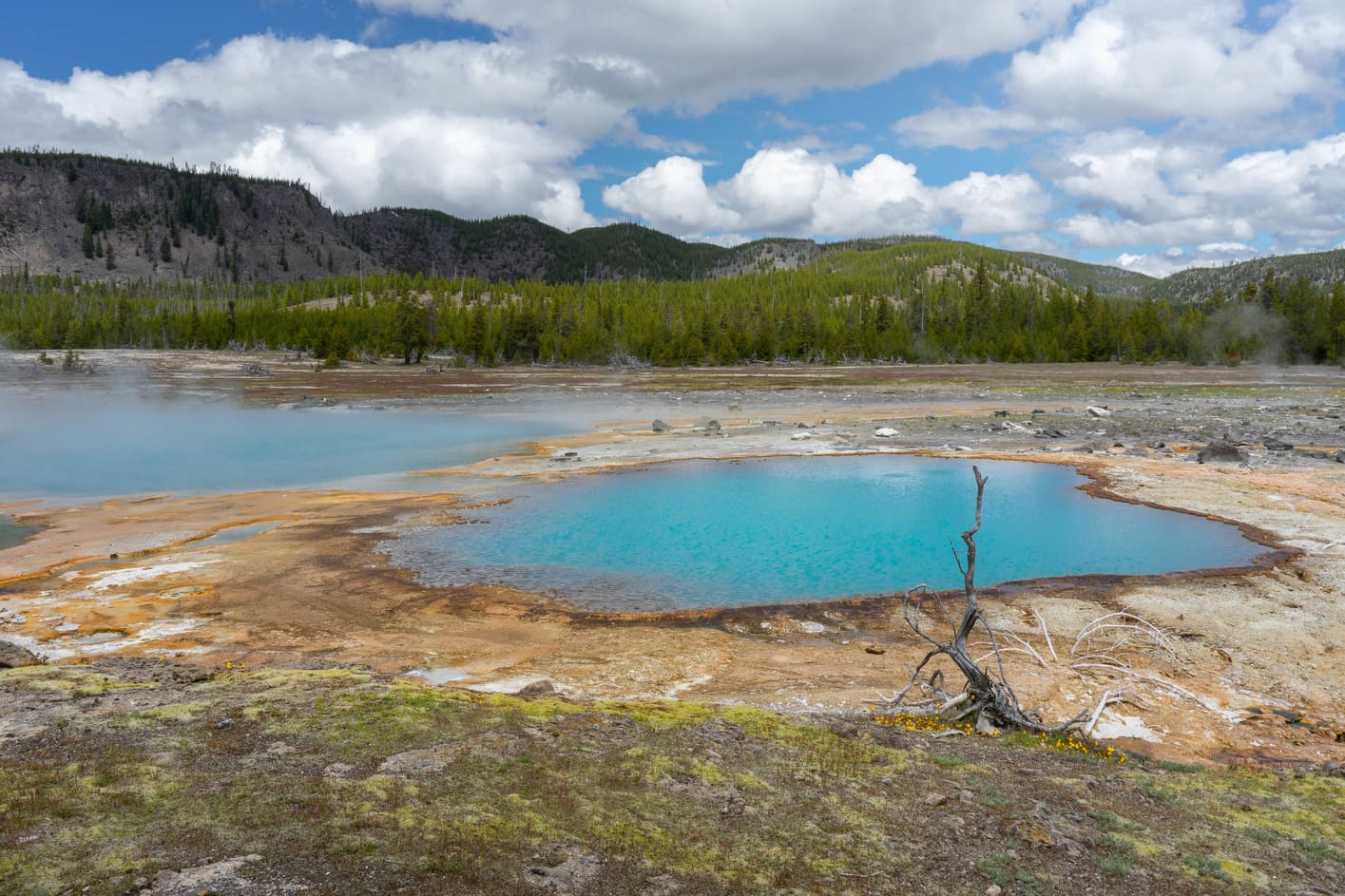
9. Biscuit Basin, pure geothermal activity in Yellowstone
In the main Biscuit Basin area, the one most tourists visit, there is a walking area surrounded by brightly colored hot springs, such as the Sapphire Pool and the Black Opal Pool. If you have already seen the Morning Glory Pool, these may not impress you, but as they’re much more accessible than the previous one, since you can park your car a few steps away, these fountains are much more crowded.
Still, it is a must-stop in Yellowstone. In addition, the 1.24-mile trail to Mystic Falls departs from there.
10. Black Sand Basin, another thing to do in Yellowstone Park
Black Sand Basin is on the other side of the Grand Loop Road in front of Old Faithful, also in the Upper Geyser Basin, and is another of the essential places to visit in Yellowstone. Some hot springs, such as the beautiful Opalescent Pool, the Handkerchief Pool, and the incredible Emerald Pool, are here.

10. Black Sand Basin, another thing to do in Yellowstone Park
However, what I like the most about the Black Sand Basin is Cliff Geyser, a geyser that is almost always bubbling along the banks of Iron Spring Creek, surrounded by beautiful and striking reddish colors. It is certainly one of the most popular attractions in Yellowstone.
11. Lone Star Geyser, a must-see in Yellowstone National Park
Lone Star Geyser is a solitary geyser that erupts approximately every 3 hours and is located south of Old Faithful, also in Upper Geyser Basin.
From the Lone Star Geyser’s parking lot, it takes about 40 minutes to get there, so to avoid waiting for hours for it to erupt, or, even worse, arriving just when the eruption is ending, I advise you to first go to the visitor center in Old Faithful, which is just a 10-minute drive away, to ask when the last time it erupted was.

11. Lone Star Geyser, a must-see in Yellowstone National Park
We left with an hour to spare so we could enjoy the remote trail. We even got to see a black bear! Upon arrival at the geyser, we had one of the most beautiful experiences of the trip. The Lone Star may not be the tallest of the geysers, but it’s just magical, and watching it erupt, surrounded by pine trees and with no one else around, is something we will always remember. There are many geysers in Yellowstone, but this is definitely worth the 4.8-mile hike.
12. Swimming in the Firehole River or the Boiling River, something to do in Yellowstone
The Firehole River is a river that runs from Madison to Old Faithful through the Lower, Midway, and Upper Geyser Basin. On its way through the most geothermally active part of the park, the river temperature increases. However, the truth is that, in the Firehole River Swimming Area, which is where bathing swimming is allowed, the water will be chilly, similar to any river or lake you’ve swum in before. Still, the area is beautiful, and I recommend you visit it.
You’ll need to drive the one-way Firehole Canyon Drive through the narrow canyon that runs through the river in this section. The road is only open in the summer, but we couldn’t enjoy swimming in the Firehole River either because the bathing area was closed for maintenance.
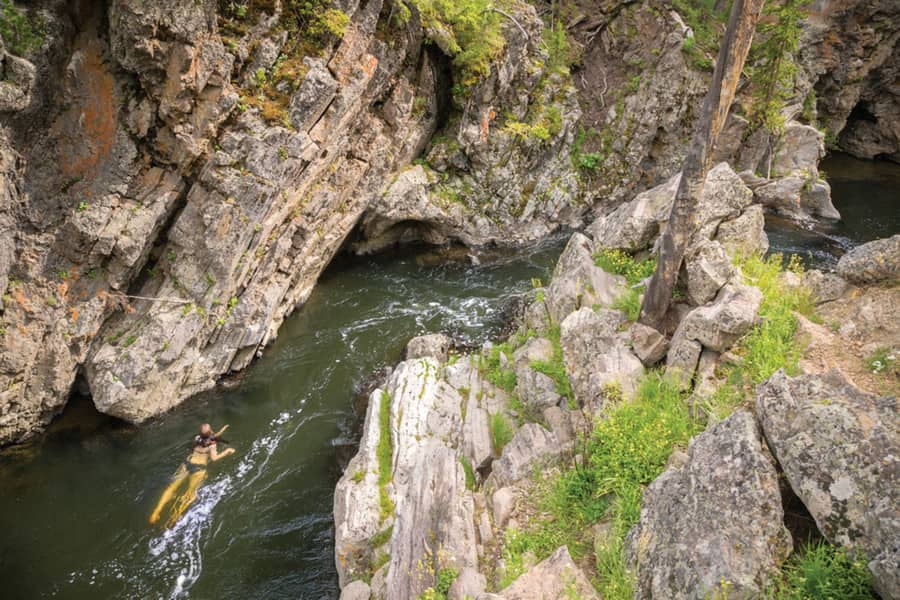
12. Swimming in the Firehole River or the Boiling River, something to do in Yellowstone
Another option, if you want to bathe in a hot spring in Yellowstone, is to head to the Boiling River. This river is close to Mammoth, and the water is a higher temperature, as hot springs flow over the Gardener River there. This bathing area is only open from late summer to early spring, so it’s a great plan to do in Yellowstone in the winter if you want to forget about the cold. Of course, wrap yourself up because, to get to the bathing area, you will have to walk about 0.5 miles.
Whether you decide to cool off at the Firehole River in the summer or warm up in the Boiling River in winter, bathing in one of these rivers is the best thing to do in Yellowstone.
13. Firehole Lake Drive, one of the best scenic drives in Yellowstone
The one-way Firehole Lake Drive runs through part of the Lower Geyser Basin. Along this road, you will discover places like Firehole Spring, the beautiful Surprise Pool, and the White Dome Geyser. However, the main attraction of this route is the Pink Cone Geyser, a must-see in Yellowstone.
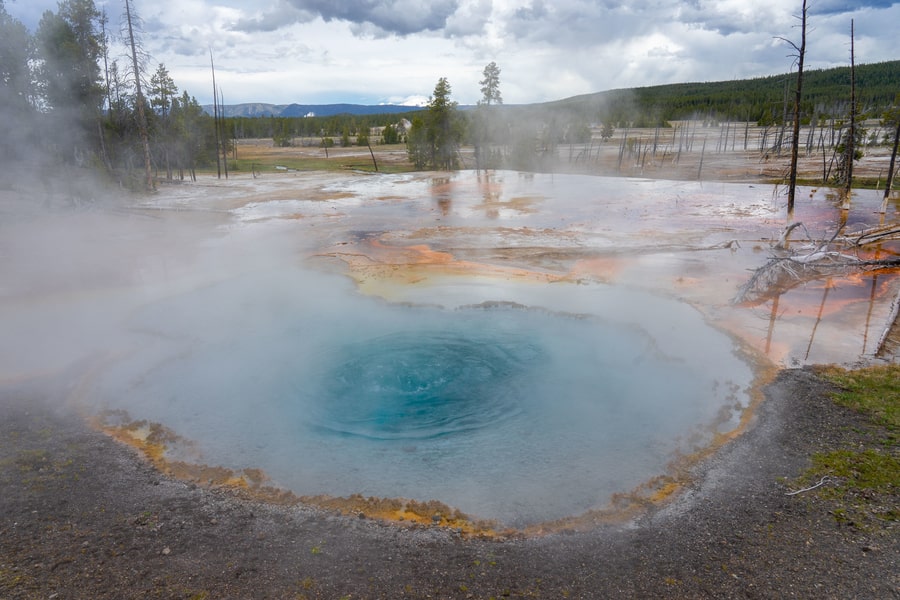
13. Firehole Lake Drive, one of the best scenic drives in Yellowstone
At the end of the road, you will reach Hot Lake and Firehole Lake. Then you can rejoin the Grand Loop Road again, but not before visiting the Fountain Paint Pots, another interesting attraction in Yellowstone.
Here, you will find the beautiful blue Celestine Pool, the Leather Pool, and the Jelly Geyser. As you can see, hot springs and geysers are everywhere throughout Yellowstone National Park, but you won’t get bored. Each one is unique and special.
14. Fountain Flat Drive, a good place to go in Yellowstone to spot bison
Lamar Valley is the most popular place to spot wildlife in Yellowstone. However, not all visitors come to that area, especially those who are spending little time in the park and staying in West Yellowstone, the best place to stay in Yellowstone.
If you don’t have time to include Lamar Valley in your itinerary, then visiting Fountain Flat Drive, in the Lower Geyser Basin and very close to Firehole Lake Drive, is a cool thing to do in Yellowstone. On this dead end, you will visit some incredible meadows full of bison, and, with some luck, you will see them cross the Firehole River.
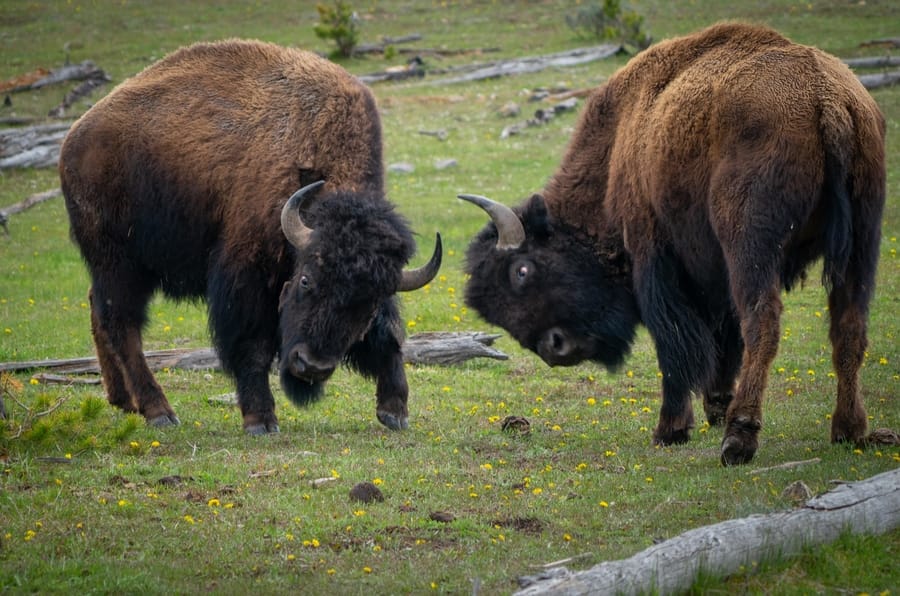
14. Fountain Flat Drive, a good place to go in Yellowstone to see bison
At the end of the road, you will see that the driveway is cut with a large concrete block. However, if you have a bike, this is one of the best trails you can bike in Yellowstone.
The Fountain Freight Road Bike Trail runs for 4 miles past pastures where it is quite easy to see black and grizzly bears. At the end of the journey, you will be at the back of the Midway Geyser Basin. Specifically, you will connect with the route to the Fairy Falls Trail that we have already talked about, where you will have spectacular views of Grand Prismatic Spring. To get to the Fairy Falls, you must park your bike and walk the 3-mile there-and-back trail of the last section.
15. Yellowstone Lake, an essential landscape to see in Yellowstone
Yellowstone Lake is the largest lake in America at a high altitude (7,700 feet). It stretches along 132 mi2 and freezes completely in winter. It isn’t in the most touristy area of the park, so unless you are going to drive the Grand Loop Road entirely, you may miss it. The water is 5ºC throughout the year, so it isn’t a lake where you’d want to bathe. Despite the cold temperatures, the bottom is full of signs of geothermal activity, such as hot springs that are above 212ºF, fumaroles, and geysers.
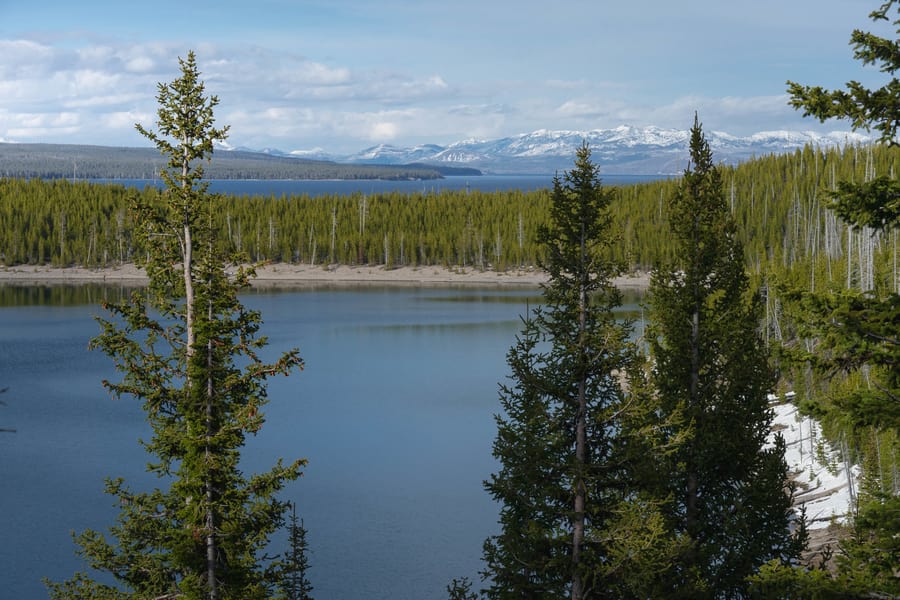
15. Yellowstone Lake, an essential landscape to see in Yellowstone
Although most geothermal features cannot be seen with the naked eye, parking your car by the lake and enjoying the scenery is a must-do in Yellowstone. If the wind doesn’t blow, you will have a perfect reflection of the snowy mountains that surround it.
In terms of the hiking trails near the shore, I recommend the 2.3-mile loop that passes through Storm Point. However, to see the volcanic nature of the lake, I recommend you visit West Thumb Geyser Basin, where it is more than evident.
16. West Thumb Geyser Basin, a great place to visit in Yellowstone Park
West Thumb Geyser Basin is an area of high geothermal activity located on the shores of Yellowstone Lake. It is just half an hour from Old Faithful and on the side of the road that connects to Grand Teton National Park, so if you are going to visit this national park, don’t hesitate to stop there. – Check here the 15 best things to do in Grand Teton.
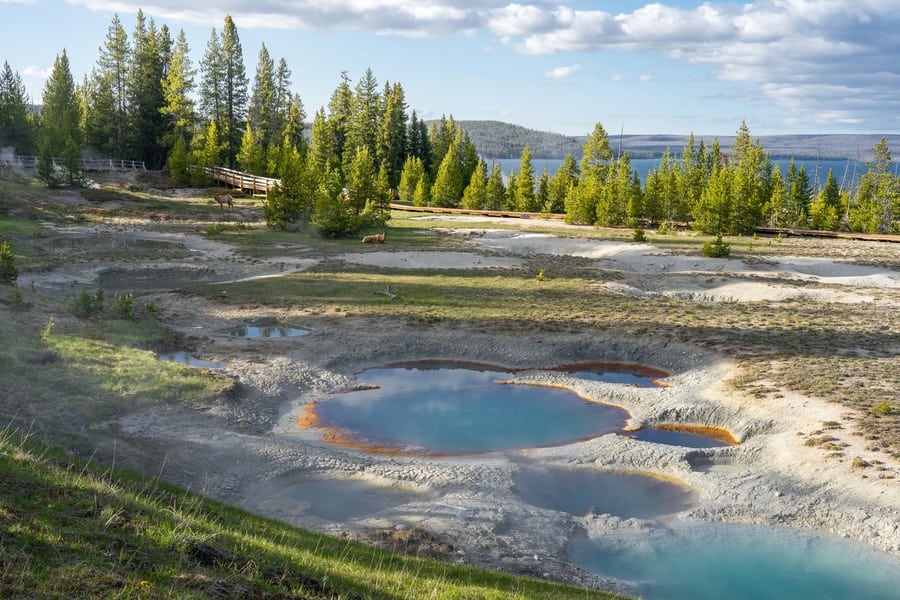
16. West Thumb Geyser Basin, a great place to visit in Yellowstone Park
The views from West Thumb are amazing, not only for admiring the volcanic activity in the area, but also for taking a fascinating walk along the shores of the lake. You will find the Abyss Pool, which has an intense light blue color; the Fishing Cone, a chimney-shaped geothermal spring that stands out above the lake; and the Lakeshore Geyser, a geyser that erupts on the lake itself.
Whether you plan to walk the entire Grand Loop Road, visit Grand Teton National Park, or just stray a bit from your visit to Old Faithful, the West Thumb Geyser Basin is a must-see in Yellowstone.
17. Natural Bridge, one of the most popular hikes in Yellowstone
Hiking to Natural Bridge is one of the best things to do in Yellowstone if you like hiking or cycling. It is a 2.48-mile round trip route that crosses a wooded area and reaches a 59-foot stone bridge.
A bridge of incalculable beauty, it was naturally carved out of the rhyolite rock by the Bridge Creek stream. When you get to it, keep in mind that walking over the bridge is not allowed, since, in addition to being dangerous, it could collapse.
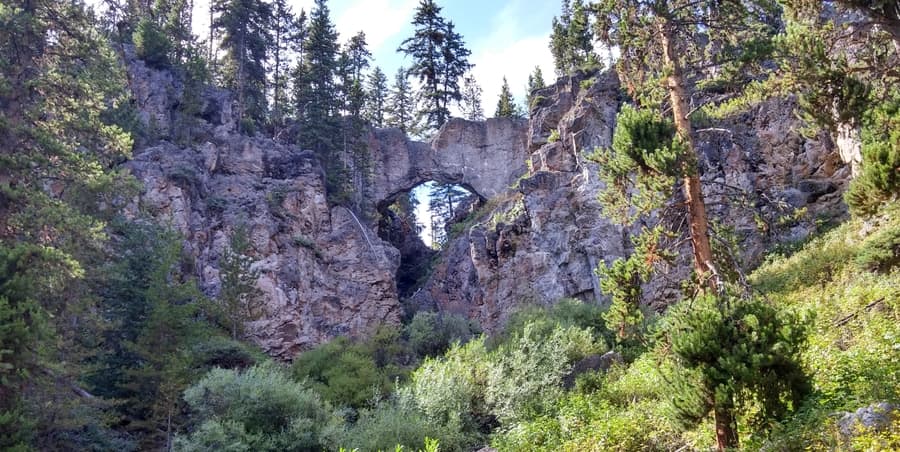
17. Natural Bridge, one of the most popular hikes in Yellowstone
The route starts from Bridge Bay, on the banks of Yellowstone Lake, only half an hour from West Thumb Geyser, so if you are driving the whole Grand Loop, it is a stop that I recommend you do.
It can only be visited in the summer. In spring, the trail is closed, as it is an area that is heavily frequented by bears. Many trout from Yellowstone Lake swim upstream of Bridge Creek to spawn, an opportunity for bears to feast on fish.
18. Mud Volcano, one of the top-rated attractions in Yellowstone
Mud Volcano is one of the few major geothermal basins located in the eastern part of the loop, so it doesn’t receive as many tourists, despite being one of the most impressive things to do in Yellowstone. At least, one of the most different.
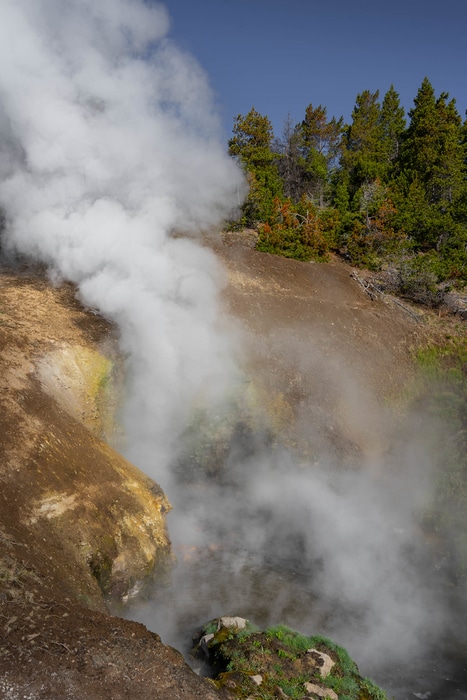
18. Mud Volcano, one of the top-rated attractions in Yellowstone
Here, you won’t find hot springs with attractive colors, but you will find mud, steam, and sulfur. To walk on its 0.6-mile path is to enter an unknown planet. Definitely something I recommend you do in Yellowstone.
Some of the highlights are Grizzly Fumarole or Dragons Mouth Spring, although the entire trail is truly spectacular. It is the most acidic area in the entire park, where sulfuric acid has managed to transform rock into clay. Gases like hydrogen sulfide and carbon dioxide explode dramatically under the mud layers, creating unique landscapes. Mud Volcano is one of the tourist attractions in Yellowstone that cannot be left off your itinerary.
A few feet away and on the other side of the road, you will find the Sulfur Cauldron, a pool of bubbling sulfuric acid where I also recommend you stop.
19. Hayden Valley, a good place to spot wildlife in Yellowstone
Hayden Valley is a 50-mi2 paradise, away from the tourist masses, for bears, buffalo, wolves, elk, and other animals in the park.
This valley of vast alpine meadows, through which the Yellowstone River runs, stretches from Yellowstone Canyon south to Yellowstone Lake, forming a hidden place reserved for wildlife where most tourists barely stop. However, if you want to explore it thoroughly, there are some amazing trails to hike.
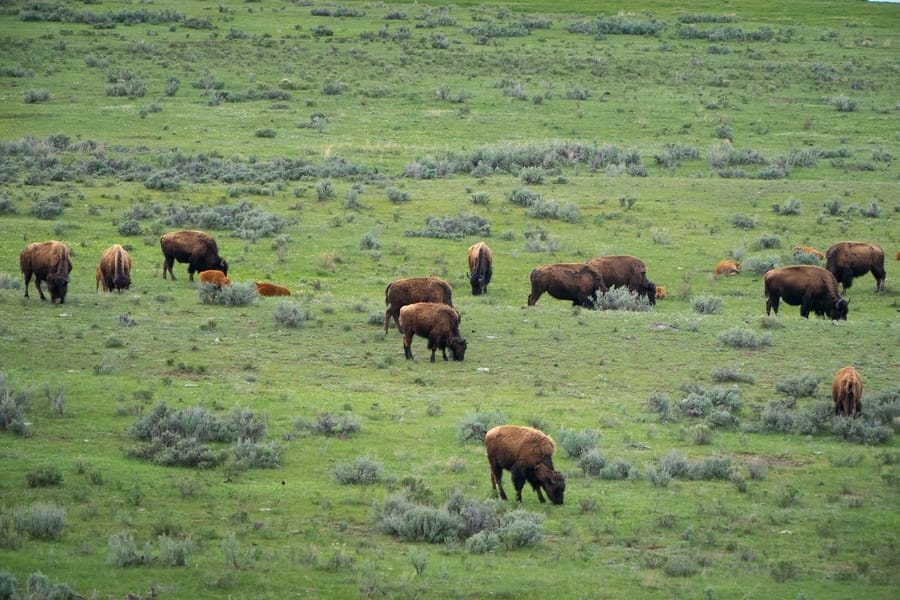
19. Hayden Valley, a good place to spot wildlife in Yellowstone
Mary Mountain is arguably one of the best, as it runs across the entire Hayden Valley to Madison on a 20-mile one-way trail where you’ll have to cross several rivers on foot. It is not a hike I recommend doing from start to finish, since doing it there and back on the same day is impossible, so you should get picked up on the other side. However, doing the first section of both the east and west zones is a good option.
The eastern area is the Hayden Valley itself, so you can find plenty of wildlife there. Carrying bear spray is mandatory, since it is one of the places where it is easiest to see grizzly bears (check our article on how to avoid bear attacks ). If you start the trail from the west, in addition to spotting wildlife, you will see fumaroles, hot springs, and other geothermal features, since you will depart from the Lower Geyser Basin.
Are you looking for something shorter but just as exciting? Then, the Pelican Valley Trail is the best option. The round trip trail is 6 miles long, and you will also see a lot of fauna there.
20. Tower Fall, one of the best things to do in Yellowstone National Park
If we follow the course of the Yellowstone River upstream, beyond the Canyon of the Yellowstone, you will find Tower Creek, a tributary of the Yellowstone River that has a nice 131-foot tall waterfall that pours its waters into the river. Tower Fall is located a few feet from the Grand Loop Road, making it an essential stop if you visit this part of the park.

20. Tower Fall, one of the best things to do in Yellowstone National Park
From there, there is a path that allows you to descend to the Yellowstone River shore through the closed canyon the river passes in this part of the park. The final section is quite exposed and steep. It is not something I recommend you do in Yellowstone with kids, even though I saw several families who managed to lower their little ones to the sandy beach of the shore. However, if you are agile and you want to get to one of the most beautiful places in the park, going down to the Yellowstone River is a great option.
Once you’re back up at ground level, and driving north, you will arrive at the Calcite Springs viewpoint, another essential point where I recommend stopping. From there, you will see this area of the Yellowstone canyon, where the strong geothermal activity that stains the rhyolite rock with whites, reds, and yellows stands out, as well as the band of basalt columns that adorns the upper part of the opposite rim of the canyon. This is a natural wonder you have to see in Yellowstone.
21. Petrified Tree, one of the top things to do in Yellowstone National Park
The Petrified Tree is just 10 minutes from Tower Fall and will take around 15 minutes to visit, making it a stop I recommend you make in Yellowstone National Park. It is a giant sequoia that petrified tens of millions of years ago. The violent volcanic eruptions that occurred in Yellowstone filled the pores of this gigantic tree with mud and ash, turning it into rock.
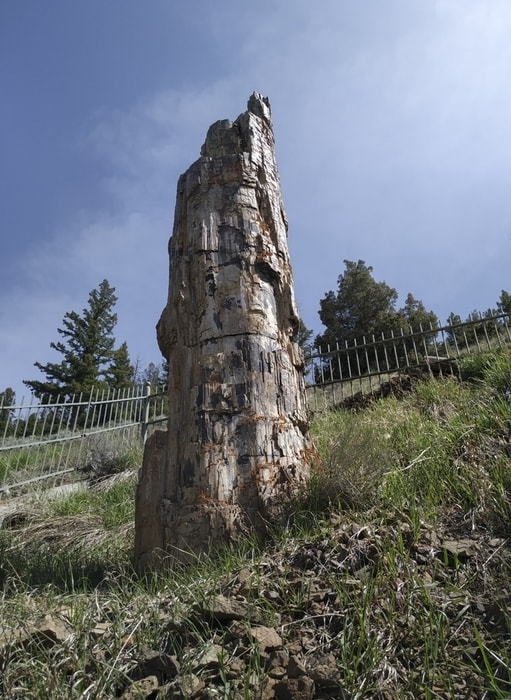
21. Petrified Tree, one of the top things to do in Yellowstone National Park
Unfortunately, when this old petrified tree was found, it was next to another tree that petrified in the same way, which visitors took fragments from, so it ended up disappearing. To prevent this tree from suffering the same fate, it was fenced off, and today the Petrified Tree is one of the most important geological gems to visit in Yellowstone.
If you want to see other petrified trees in the area, at the entrance to Lamar Valley, and just 15 minutes from the tree, start the Petrified Tree Trail, where you will travel 4 miles through an ancient redwood forest that has been transformed into a meadow where you can still find some trunks and fragments of petrified trees. Here you can find all the trail details.
22. Undine Falls, one of the best Yellowstone roadside attractions
On the route from Tower Junction to Mammoth, you will pass by the beautiful Undine Falls, where I recommend you make a quick stop. They are bythe roadside, so it won’t take you more than 5 minutes.
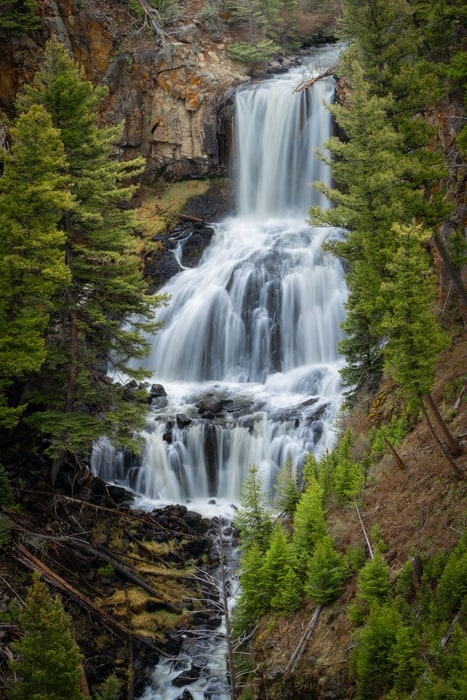
22. Undine Falls, one of the best Yellowstone roadside attractions
However, if you want to get a different view than the one from the road, I recommend taking the Lava Creek Trail. This pretty trail is 4 miles one way, although taking a 1.7-mile there-and-back trail from Undine Falls is enough to see the waterfalls from another perspective.
A two-minute drive from Undine Falls and across the road is the 1 mile there-and-back trail that leads to Wraith Falls, another Yellowstone waterfall worth visiting.
23. Sheepeater Cliff, the basalt columns to see in Yellowstone
Yellowstone offers several opportunities to see the mysterious columns of basalt that appeared in the park after the basaltic floods of the Yellowstone caldera more than 500,000 years ago. However, if you want to see the hexagonal shape of these structures up close, there is no better place than Sheepeater Cliff, a picnic area where you can have lunch at the foot of these amazing columns.
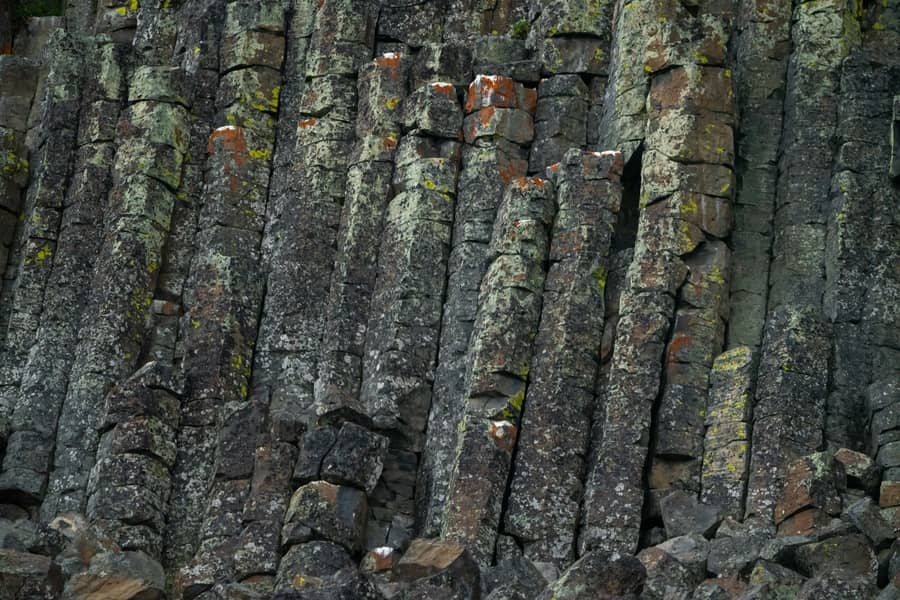
23. Sheepeater Cliff, the basalt columns to see in Yellowstone
Basalts occur in many areas along the Gardner River but are mostly inaccessible, so the best area to see them is this cliff that lies between Mammoth and Norris and is accessible by car.
Twelve minutes south, there is another stop that I recommend you do in Yellowstone, the Roaring Mountain, a hill full of fumaroles. In the early 20th-century, steam ejections through the mountain openings were so strong that they were heard for miles. Today, they are not that impressive, but it’s still a sight worth visiting in Yellowstone.
24. Beaver Ponds Trail, one of the best hiking trails in Yellowstone
The Beaver Ponds Trail starts from Mammoth and heads north, with a steep climb in the first section but a constant altitude throughout the entire route. In the first part, you will go through open slopes where it is easy to see elks and even black bears and grizzlies.
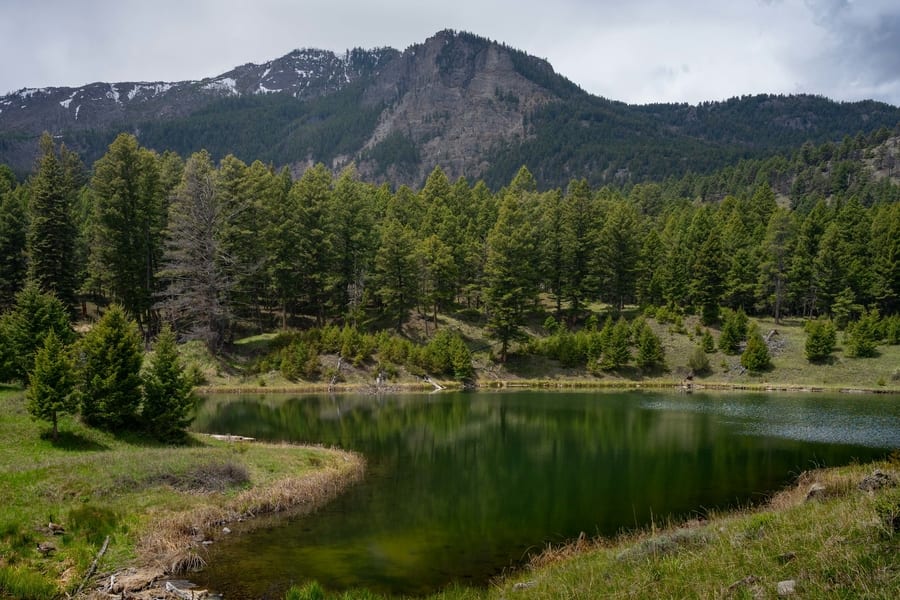
24. Beaver Ponds Trail, one of the best hiking trails in Yellowstone
Then, you will enter a pine forest. Halfway along the trail, you will reach the ponds and lakes where it is possible to see beavers, although it is much more common to find muskrats. However, the views from there are wonderful and well worth it. If you like hiking, it is one of the best things to do in Yellowstone.
It’s a 5-mile loop that you can hike in 3 or 4 hours. The trail ends at the Mammoth Hot Spring, making it the perfect opportunity to see it from another perspective.
25. Gibbon Falls, another Yellowstone tourist attraction
Gibbon Falls is the last tourist attraction to visit in Yellowstone. This is a gradual 82-foot falls and, although not as spectacular as others in the park, is worth a stop.
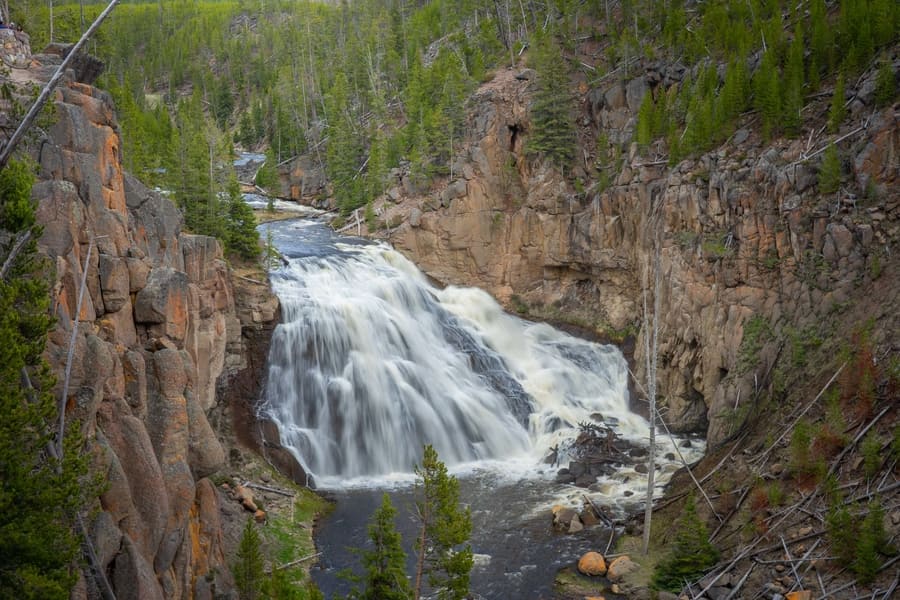
25. Gibbon Falls, another Yellowstone tourist attraction
It is between Norris and Madison, one of the most popular areas of Yellowstone, so it can be difficult to find a place to park there. The path that gives you the best view of the waterfall is quite easy. I loved it since I could see a colony of marmots inhabiting the other side of the canyon next to the waterfall.
And these are my 25 recommendations of things to do in Yellowstone. I hope they help you when planning your travel itinerary and that now you have a better idea of which places you want to visit.
To help you locate the main tourist attractions in Yellowstone, I have pointed them out on the following map.
You can also download our map of Yellowstone to use it offline during your trip.
Do you know any other essential places to visit in Yellowstone? Leave me a comment and in addition to adding it to our list, I will visit it on my next trip to this incredible national park.
Safe travels!
